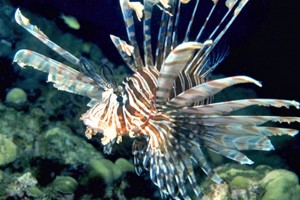It seems everyone in the Panhandle is talking about the invasive lionfish. This non-native member of the scorpionfish family was first seen in U.S. waters in 1989 near Ft. Lauderdale. Over the last two decades, much has been learned about the biology and potential impacts of lionfish in our waters; For additional background information you can read more at these websites http://myfwc.com/wildlifehabitats/nonnatives/marine-species/lionfish and http://escambia.ifas.ufl.edu/marine/2012/08/17/the-invasion-of-the-lionfish
This past October, the Florida Fish and Wildlife Conservation Commission held the first state lionfish summit in Cocoa Beach. Researchers, fishery managers, divers, fishermen, and the general public received research updates, discussed current issues, and provided input regarding future management needs. Here are a few of the interesting highlights from the summit.
What are the potential problems?
- Several theories on how lionfish were initial released into state waters have been suggested. However, research results now indicate a single introduction of lionfish in Florida initiated the invasion into the Western Atlantic presumably from just a few aquarium specimens.
- Sixty-thousand lionfish continue to be imported into the state each year.
- Compared to native Pacific population, Florida densities of lionfish are much higher; 400 fish/hectare in Florida compared to 80 fish/hectare in the Pacific. On average, invasive Atlantic Lionfish individuals are larger than the native populations in the Pacific basin.
- Studies from Pensacola showed that lionfish population has doubled annually since 2010 and lionfish densities are highest on artificial reefs.
- Invasive lionfish have no natural predators and may spawn 30,000 – 40,000 eggs every 2 to 4 days.
- Another potential problem reported are records of lionfish entering the Loxahatchee and Indian Rivers; indicating that they are able to move into brackish water.
What are the negative impacts?
Young lionfish feed primarily on crustaceans and when they are older they prey on reef fish. Research and stomach analysis indicate 70 different reef fish species as potential prey. Lobster fishermen in the Keys found lionfish are the leading by-catch species and have reduced lobster harvest by as much as 50%. Another study indicates lionfish on natural reefs they prefer blennies. However, on artificial reefs they feed on small snappers, sea bass, and groupers. Finally, an interesting study compared primary reef predators. Reefs with only grouper there was a 36% decrease of juvenile fish while reefs with lionfish the decrease was 94%.
What can be done?
Several reports indicate that collecting tournaments are effective; Lad Akins of Reef Environmental Education Foundation (www.reef.org) reported a 69% reduction of lionfish from one event in Key Largo. Another study had similar results but indicated that some spear fishermen were more successful than others, suggesting training may be required to increase efficiency.
Other reports indicate that work where native fish were introduced and conditioned to consume lionfish have led these native predators to follow and even bite divers thinking that “free food” may be available; it was suggested that this idea not be pursued.
Locally, lionfish rodeos sponsored by Emerald Coast Reef Association occur frequently in Okaloosa County. Escambia County Marine Resources hosted a pilot event this summer. Escambia will begin a full lionfish control program in 2014. If you have questions or comments, please contact your local UF/IFAS natural resource or Sea Grant Extension Agent.
Please note: UF/IFAS and Florida Sea Grant does not organize volunteers to participate in local lionfish control events; this is done by independent community groups. UF/IFAS and Florida Sea Grant provides this information about food safety concerns associated with eating lionfish. Click here for more information.
- St. Joe Red Tide Claiming Terrapins - December 15, 2025
- The 2025 Snake Watch Report for the Pensacola Bay Area - December 15, 2025
- Rattlesnakes on Our Barrier Islands; Part 2 – Prey Selection - December 15, 2025

